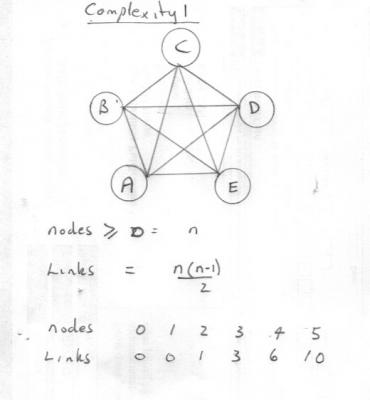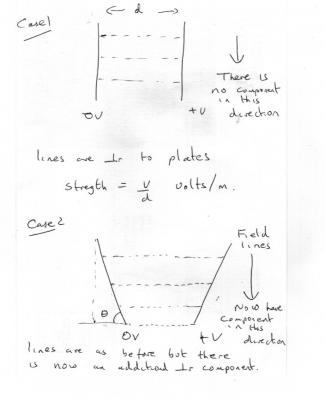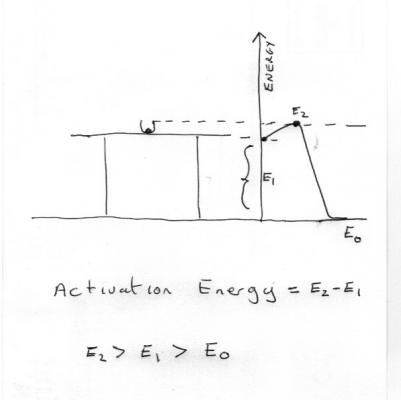-
Posts
18270 -
Joined
-
Last visited
-
Days Won
104
Content Type
Profiles
Forums
Events
Everything posted by studiot
-
In order to put some flesh on the bones of my question here is an introduction to infinite and complexity for discussion Infinite We say an infinite something. But what? Consider the following two lists (sequences in maths) 1, 2, 3, 4.................. tan (0), tan (15), tan (30), tan (45), tan (60), tan (90) The first list is an infinite list of positive integers. That is is does not terminate or goes on forever. The list has no end. So we say it is an infinite list or sequence. But every one of the integers on that list has finite magnitude, ther are no infinite 'numbers' on the list. The second list terminates or contains a finite number of items. So it is not an infinite list. Yet one of the items on the list has infinite mgnitude. This is what I mean when I say that we have to be clear what we are applying the adjective infinite to when use it. As above some properties may be infinite, whilst some may remain finite. Complexity. This is a noun and again it can be taken in more than one way. Here is one interpretation, that can lead to a concept of infinite complexity, along the lines of the first example above ie it never ends. Consider a list of items, such as facts, theorems, properties etc. Call these items A, B, C, D, E etc Now these items may be linked by connections of some sort, eg equations or whatever. The totality of all the connections can be regarded as a measure of the 'complexity' of the system. The following diagram shows the maximum number of single links for 5 items, where every item is linked once to every other item by connections shown as lines. A formula and list for other numbers of items is also shown. You can see that in this model the system comprises the items and the links and the complexity is given by a simple formula such that the complexity remains finite so long as the number of items remains finite. However the complexity becomes infinite for an infinite number of items. Does this help the discussion?
-
I don't know, but I do know that I made a genuine offer to rationally discuss the terms you used, by asking my question in post#25 to which you have not responded. It is against the rules of this forum to ignore polite questions in this manner.
-
Whilst you deserve acknowledgment for adding the important word 'might', you still have not explained what you mean by complexity. This is important because infinite is an adjective that has at least a couple of meanings, but it has to have something understood to be applied to. So what is your explanation of complexity and what about this explanation can the word infinite be correctly applied to?
-

Converting chemical structure to a molecular formula
studiot replied to Aussiek's topic in Organic Chemistry
This example brings up another point for down the track. The pentagon is a closed shape, called a ring or cyclic structure for obvious reasons, however it is not the most common or important one. You should always be aware which ring you mean, it is particularly, if your glance is too quick you can confuse the pentagon and hexagon. The hexagonal benzene ring is the most common arrangement and the basis for a large branch of organic chemistry, the aromatic compounds. http://www.2b1stconsulting.com/benzene/ -
Well we should be well protected since all our mods are now godesses.
-
A walks towards B. But B is walking towards C who is walking towards....... etc So A is constantly turning inwards as he is always walking directly towards B. Draw a sketch and you will see what i mean.
-
Foxy has a point. This reminds me of the following question. Four circus performing fleas are placed at each corner of a 1 inch square ABCD. At the ringmaster's whisltle all the fleas start to walk towards their neighbour. So A walks towards B, who walks towards C who walks towards D, who walks towards A. They all walk straight towards their target at all times. Since they are all in motion each flea walks a spiral path and they meet in the centre. How far does each flea walk?
-
In all cases the field strength equal the voltage divided by the plate separation E = V/d But in the second case the plate separation varies, due to the geometry so this induces a second component, perpendicular to the original, as the field strength increases from bottom to top, as in the diagram. This causes the electron's path to curve. Is this really an A level question?
-
1) What do you think the path of the electron will be in both cases? 2) sketch the lines of constant field strength in both cases. 3) What is the angle between the constant field strength contours and the Force on the electron. 4) What do you think this does to the path of the electron?
-
Thank you. A single hydrogen atom has one electron. So this is the only case in which the issue of which electron does not arise. swansont's replies show that even here the possibilities are beginning to get complicated, and I am struggling a little bit to find a level to answer. So here goes, here is the simplest answer I can think of. Moving the electron to a higher energy level moves it further out from the attracting positive nucleus. So electrostatic attraction will pull it back in, if at all possible. This is similar to saying that if you throw a stone up, gravity will pull it back down to Earth. Also similar to gravity, where if you (or the HULK) throws it up hard enough the stone can leave the Earth entirely, it is possible to remove that electron and take it away somewhere so that it will never fall back o its original state. That is what I meant by the environment and the process of excitation. Not important in single hydrogen atoms, but very important in thermionic emission or conduction bands in semiconductors or conductors.
-
Several things need amplification here. First and foremost the energy state belongs to the environment of the electron, not to the electron itself. Secondly the above quickly glosses over the means by which the excitation occurs. Thirdly it may not be that specific electron that 'falls back' to the lower state. So please tell us more about the context of the question. Is the electron in an atom, a molecule, a metal, free space or what before excitation? Secondly what method of promotion are we discussing, light, heat, electric field or what?
-
The commonly called Principle of Equivalence boild down to an assertion that the m in inertial equations, such as Newtons 2nd Law, is the same as the m in gravitational laws (Newtons included). This has been repeated demonstrated experimentally to ever greater levels of precision. Eotvos experiments confirmed it in Einstein's day. The principle has often been quoted as its logical consequence or deduction viz that a blindfolded observer cannot tell the source of a hidden acceleration she experiences.
-
Do electrons collide?
-
Fine, look out for the next post about entropy and surface energy. BTW what are you studying? You originally said this came up in Chemistry, so I have been trying to put things from a Chemistry point of view.
-
Noonespecial, Please note, I am not saying everything you say is wrong. Far from it. But I am saying it is only part of the whole story, as with my example of area or ajb's ones from mechanics. But you are practising what mathematicians (and other scientists) often do. Limiting the scope of your domain of discussion to achieve internal self consistency. This is fine so long as you acknowledge these limits and do not try to apply the results outside their scope. Much misunderstanding arises from failure to do this. Now we have (hopefully) agreed that multiplication can lead to new things outside the scope of your definitions, let us revisit addition. What is 10 plus 7? but It is 10 o'clock. What is the time if I add 7 hours? The recipe for a cake reads "Add two eggs to the dry ingredients." What do I have if I add two spoonsfull of sugar to my cup of tea? What do I have if I add oil to water? Chemical safety instructions read "Always add acid to water, never water to acid" One of the properties of addition to explore in the above is What happens if I switch the quantities being added That is is (a + b) the same as (b + a) We often want this in mathematics and often phrase our rules to force this. But you can see that in the real world this is not always the case. Now interestingly consider the same question for subtraction That is is (a - b) the same as (b - a) If you really want discussion, not a platform, the above are some points of discussion about your material for you to respond to.
-
Once again you are preaching at me, instead of responding to what I actually said. Let us lay this multiplication ogre once and for all. Your explanation / definition of multiplication is a version of replication. This totally fails to include other aspects of multiplication, not accessible from addition, that have physical reality in the real world. The very simplest example is Multiply 6 x 5 and get 30 or 6 + 6 + 6 + 6 + 6 This is certainly true if I had 5 packets of half a dozen apples I would have 30 apples. This is an example of replication in the real world. But if, instead of apples, I told you that these were the measurements of my front lawn in metres I would not have 30 of the objects I started out with. I would have one new object - 30 square metres, of lawn. Neither the 6 metres nor the 5 metres by themselves refer to lawn as a line (of lawn) with no width is not a physical reality. This business of area has important implications for electrical circuit theory as well. BTW I agree that physics and maths often diverge and I have given many examples myself. But until we have a two way conversation going, we will be unable to discuss this.
-
Once again you seem to know it all despite the evidence to the contrary. Why did you ask for a link to negative mass? I posted a page full of them, did you not read it? You should always be aware that the mathematical statement 'There exists' means something different from the same statement in the physical world. The mathematical statement means "Is compatible with the given definitions, axioms and derived theorems" The physical statement has been the subject of philosophical debate for millenia. Neither are really suitable (as should be the rest of Science) for a belief system.
-
Not quite. The energy state or total energy is larger but the activation energy is usually small compared to the total energies as in the diagram. Look again at my description of the ball in the bowl. The potential energy on the table is much larger than the activation energy needed to get the ball out of the bowl. This situation is very important in chemistry since most reactions involve an activation energy. Some types of catalysts work by reducing this activation energy. I will leave discussion of entropy to another post since it is also important but a very large subject by itself and will involve several diagrams. I am glad to see someone more interested in real science than some of the sillyness we see in other threads. Keep it up.
-
I am not discouraged, just weighing up if this discussion is worth the effort. I also said that power was the result of multiplication of two (usually sine) waves ie their product. Instantaneous Power = Instantaneous voltage times Instantaneous current. This cannot be achieved by addition. Since we have moved on to addition, here are some thoughts. Conventionally we discuss addition in terms of numbers. This leads to one of the conceptual difficulties to be avoided in mathematical philosophy. To avoid the circular argument of defining numbers in terms of addition and addition in terms of numbers. You have avoided this but fallen into another bear trap set this time by nature and physics. You are not likely to have come across this but it is possible to add something in one place without subtracting it somewhere else. In solid state physics we discuss conduction by electrons and 'holes'. The particles display some interesting properties, not the least being that they sometimes behave as if they possesed negative mass (this is part of what we call the Hall effect) https://www.google.co.uk/search?hl=en-GB&source=hp&biw=&bih=&q=negative+mass+in+the+hall+effect&gbv=2&oq=negative+mass+in+the+hall+effect&gs_l=heirloom-hp.3...1267.19966.0.21414.32.22.0.10.2.0.180.2293.7j15.22.0....0...1ac.1.34.heirloom-hp..9.23.2275.DJnhu7xVxSk To add a hole to a solid we subtract an electron (not a hole) To add an electron we subtract a hole. Edit I will draw some diagrams and try to explain qualitatively. We often do this, use a qualitative model to attain understanding and then move on to a quantitave model (and mathematics) to obtain numbers, since we need numbers in the real (engineering) world.
-
If you plug your battery charger into the mains and it charges your battery, by drawing electrical power from the mains that is positive power. If, on the other hand the result is that the charger drains your battery into the mains that is negative power. In any ac cycle in any real world circuit both of these events happen to some extent; the engineering trick is to make the positive exceed the negative..
-
Thus far I have only addressed then first of these. Just because you could not or did not find examples does not prove they do not exist. Which is why I find it all the more suprising when I offer you something real that does display exactly this and you respond by a 24 hour course in a discipline that takes folks 5 years + to learn, and then dismissing my offer in your ignorance. I would have expected the response of a truly open and enquiring mind to be "Oh really, please explain further.?" I actually also offered the same subject as an example of multiplication, which you actually need to understand the true picture. For your infomation the point about electrical power is that during part of a cycle power is delivered from the generator to the circuit and during other parts of the cycle power is returned by the circuit to the generator. The former is positive power, the latter negative. Absolute zero power occurs when the two are equal.
-
Thought I'd read through this thread and see what all the fuss was about. Thanks for the entertainment, guys. I have sprinkled a few +1s about to Strange and Daecon for introducing and developing a line of reasoning. I am not an atheist. I'm a 'don't care' Since I'm comfortable with my lifestyle and lot it makes no difference to me whether there are gods or not, I would not change anything either way. Save's a lot of pointless effort that way for something more useful.
-

SCIENCE - What actually is Science ?
studiot replied to Mike Smith Cosmos's topic in General Philosophy
Mike, I don't know if you are seeking an explanation of the canal surface disturbance or discussing some deeper philosophy (pun intended). Anyway here is my comment on the canal. Whilst they generally have smaller flow rates than rivers, even in canals the water does flow. Any subsurface obstruction will affect the surface in some way, depending upon its disposition, size and proximity to the surface. You can observe this phenomenon in all flowing water. I suspect that there is a submerged branch or whatever, fallen from the nearby trees, that the flowing water is bumping against, roughening the surface. This roughening appears as waves which travel sideways and bounce off (are reflected off) the bank, causing an interference pattern a little downstream, which spreads out and eventually dies away. There is clearly a further longitudinal boundary, perhaps a weed bed? , perhaps the edge of the obstruction with the water being clear to pass by beyond that. -
I'm glad you have taken the time to answer. However you seem to be under some misapprehensions, this is nothing to do with pure maths, all you need is a voltmeter and sufficient knowledge of electrical engineering. The maths models the engineering, not the other way round. Power is the product of two sine or other waves and a phase shift. (did a multiplication creep in there ?) You carefully avoided the part where I said that some parts of the wave are positive and some negative. Do you know what this means in electrical engineering terms?
-
What you know is correct. you know the height of the drop and the height of the bounce back, and the PEs must be in the same ratio as these heights. you know that all the drop PE is converted to KE and similarly all the bounce back PE starts off as KE, again in the same ratio Can you put this into figures now?





